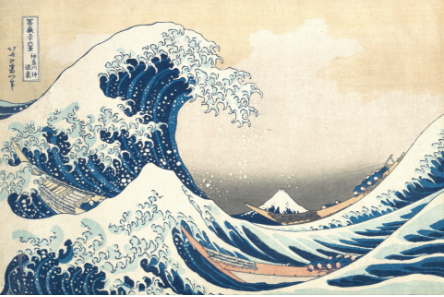Introduction
The Great Wave off Kanagawa is one of Katsushika’s most historic paintings. He is regarded as one of the most creative artists in the history of Japan. His contribution to modernizing traditional Japanese styles in his artwork earned him a name in Japan and across the globe. Most of his work celebrated Japan as a united nation, and he presented this in his artwork using landscapes and activities involving shared symbols (The British Museum, 2020). His work contributed a lot to modernism and civilization and greatly influenced him.
The Great Wave off Kanagawa by Katsushika Hokusai
Katsushika Hokusai, between 1829-1833, did the Great Wave off Kanagawa. In this artwork, the artist paints a big, looming wave approaching from the left side of his drawing (The British Museum, 2020). The wave is filled with a gray sky color that also seemingly acts as part of the sky. In the art, the great wave is drawn so that its tips appear as small white claws that target to grab the men sailing in the boats. This description hints at how the approaching wave was powerful and filled with horror, and it also shows how fragile the men in the three boats were. From the image, we can also spot smaller waves filling the foreground. It also seems that the sweeping sway of the water occurs from left to right and right to left. This brings about dynamism and drama to the scenes depicted by the artwork.

Why the Art?
The piece of art was chosen due to its relevance in modern society. It leaves the viewers of the artwork to ask themselves more questions, such as what will happen to the men in the boats? It seems Hokusai captured a future moment in the history of the world just before the massive wave hit. My image is a respectful homage to the great work done by Hokusai. He successfully portrayed the great negative impacts of civilization and modernism even before they occurred.
Recreating the Artwork
In recreating the artwork, I used a grey background, a brown pillow, a sky-blue pair of jeans, and white cotton wool. The grey background represents the landmass, and the brown pillow, on the other hand, stands for a massive boat sailing through the water, represented by the sky-blue jeans. On the other hand, the white cotton, together with the blue jeans, represented the clouds and the waves. In the recreated image, the three boats were joined to form a massive boat using the pillow; this was done to represent the dangers faced by humanity from the damages caused by humans due to civilization and modernity.
Relevance of the Art in 21st Century
In the process of recreating the image, I was able to see the impacts of modernism from a different angle. For instance, in the 21st Century, the massive wave can represent the advancement of technology in the modern world. Rapid advancement presents a serious threat to the human race. It has taken most of the jobs done by people through automation, leaving them jobless, directly threatening my professional life. The massive deployment of technology has also impacted the food production system, exposing people to processes unlike traditional organic food and causing biodiversity loss.
Conclusion
To conclude, the piece of art is relevant to contemporary society in many ways. The wave may also represent cultural erosion due to the adoption of Western cultures in African societies and the impacts of colonialism, which also came from the West as the waves in the art. But from my photo, the massive waves are represented in a manner that they are approaching one another, threatening to destroy the massive boat. This indicates how postmodernism has led to technological advancements that are currently eroding the planet.
References
Katsushika Hokusai. (1831). The Great Wave: spot the difference. The British Museum. Web.